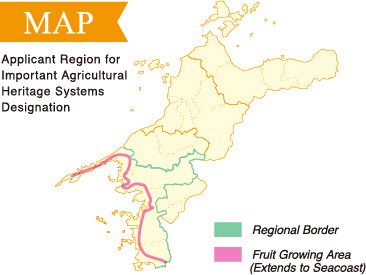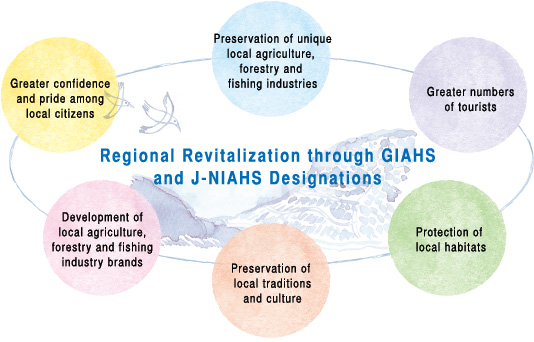Message
Toward Important Agricultural Heritage Systems Designation
- Message from the Chairperson
- Committee Members
- GIAHS and J-NIAHS Designations
- Anticipated Benefits of GIAHS and J-NIAHS Designations
MemberMessage from the Chairperson
Striving to Achieve Important Agricultural Heritage Systems Designation for Nanyo's Cherished Citrus Fruit Agricultural System

Ehime Prefecture's Nanyo region, which faces the Uwa Sea, has severe and challenging topographical conditions characterized by steeply sloping mountains and hills—typical ria coast topography. Our progenitors made use of wisdom and hard work to build terraced orchards amid these challenging conditions, creating impressive and breathtaking hillside scenery often described as "farmland that rises up to the heavens." Today, Nanyo boasts the highest production volumes and greatest production variety in Japan for citrus fruits.
While always maintaining a profound respect for the foundations laid by previous generations through backbreaking efforts over the years, we strive to foster global recognition for the Nanyo, Ehime Citrus Fruit Agricultural System for its contributions to Ehime Prefecture's success as Japan's leading citrus producer. To this end, we are striving to attain official recognition of this system as an Important Agricultural Heritage System. We ask for the understanding of producers and local citizens alike as we undertake these efforts, and hope that everyone in the Nanyo region can come together as one to pass on what we have built to future generations.
&bnsp;
&bnsp;
Ichiro Oshiro
Chairperson
Ehime Prefecture Nanyo Region Important Agricultural Heritage Systems Designation Promotion Committee
Applicant Region for Important Agricultural Heritage Systems Designation

Applicant Region Name: Nanyo Region, Ehime Prefecture
(Includes Five Municipalities: Uwajima City, Yawatahama City, Seiyo City, Town of Ikata-cho, Town of Ainan-cho)
Committee Members (29 Governments/Organizations):
Uwajima City, Yawatahama City, Seiyo City, Town of Ikata-cho, Town of Ainan-cho, Ehime Prefecture, JA Nishiuwa, JA Higashiuwa, JA Ehime-Minami, Nanyo Water and Land Improvement District Association, Yawatahama City Cultural Association, Machimi Kyodokan, NPO Kawauso Fukkatsu Project, Uwajima City Tourism Association, Minato Koryukan (Yawatahama Minatto), Seiyo City Tourism Association, Ainan-cho Tourism Association, Shikoku Seiyo Geopark Promotion Council, NPO Cape Sada Tourism Association, Ainan Green Tourism Promotion Committee, Uwajima Chamber of Commerce & Industry, Yawatahama Chamber of Commerce & Industry, Honai Chamber of Commerce & Industry, Ikata-cho Shokokai, Seiyo City's Society of Commerce & Industry, Yoshida Mima Shokokai, Tsushima-cho Chamber of Commerce & Industry, Ainan Town Society of Commerce and Industry, Uwajima Sangyo Shinko Kosha Co., Ltd. (Kisaiya Hiroba)
Giahs & JniahsGIAHS and J-NIAHS Designations
The Japanese Nationally Important Agricultural Heritage Systems (J-NIAHS) and Globally Important Agricultural Heritage Systems (GIAHS) frameworks are utilized to officially recognize unique industry systems formed through interconnections and integration between traditional agriculture, forestry and fishing industries, and local culture, landscapes,1 seascapes2 and agricultural biodiversity3 fostered through close ties with said industries. These important systems are designated under the framework in order to preserve them for future generations. A total of 57 regions/systems in 21 countries have been designated as GIAHS, including 11 in Japan (as of December 2018). Regarding national designation within Japan, 15 regions have been designated under the J-NIAHS system created in FY 2016.
- 1 "Landscape" is defined here as a collective land-based region comprising areas that have been developed by the agriculture, forestry and/or fishing industries.
- 2 "Seascape" is defined here as an ocean or sea coast area formed through activities in the fishing industry, aquaculture industry and similar industries.
- 3 Agricultural biodiversity: Rich abundance of biological diversity and germplasm (genetic resources) in relation to food resources and agriculture.
GIAHS Designation
GIAHSGlobally Important Agricultural Heritage Systems
GIAHS designation is carried out by the Food and Agriculture Organization of the United Nations (FAO) for regions active in the agriculture, forestry and/or fishing industries in globally important, traditional ways (agriculture, forestry and fishing industry systems). A total of 57 regions in 21 countries have been designated as GIAHS, including 11 in Japan (as of December 2018).
Japanese Regions/Systems Currently Registered as GIAHS
Sado’s Satoyama in Harmony with Japanese Crested Ibis (Sado City, Niigata Prefecture); Noto's Satoyama and Satoumi (Noto region, Ishikawa Prefecture); Traditional Tea-grass Integrated System in Shizuoka (Kakegawa area, Shizuoka Prefecture); Managing Aso Grasslands for Sustainable Agriculture (Aso region, Kumamoto Prefecture); Kunisaki Peninsula Usa Integrated Forestry, Agriculture and Fisheries System (Kunisaki Peninsula Usa area, Oita Prefecture); Ayu of the Nagara River System (mid– and upper–Nagaragawa River region, Gifu Prefecture); Minabe-Tanabe Ume System (Minabe and Tanabe areas, Wakayama Prefecture); Takachihogo-Shiibayama Mountainous Agriculture and Forestry System (Takachiho-kyo and Shiibayama areas, Miyazaki Prefecture); Osaki Kôdo's Traditional Water Management System for Sustainable Paddy Agriculture (Osaki region, Miyagi Prefecture); Traditional Wasabi Cultivation in Shizuoka (Shizuoka Prefecture wasabi growing region); Nishi-Awa Steep Slope Land Agriculture System (Nishi-Awa region, Tokushima Prefecture)
J‐NIAHS Designation
JNIAHSJapanese National Important Agricultural Heritage Systems
J‐NIAHS designation is carried out by the minister of Japan's Ministry of Agriculture, Forestry and Fisheries (MAFF) for regions active in the agriculture, forestry and/or fishing industries in nationally important, traditional ways (agriculture, forestry and fishing industry systems). The first J‐NIAHS designations were given in March 2017 to eight regions, and an additional seven region designations given later on February 15, 2019.
Japanese Regions Currently Registered as J‐NIAHS
Sado City, Niigata Prefecture; Noto region, Ishikawa Prefecture; Kakegawa area, Shizuoka Prefecture; Aso region, Kumamoto Prefecture; Kunisaki Peninsula and Usa area, Oita Prefecture; mid– and upper–Nagaragawa River region, Gifu Prefecture; Minabe and Tanabe areas, Wakayama Prefecture; Takachiho-kyo and Shiibayama areas, Miyazaki Prefecture; Osaki region, Miyagi Prefecture; Musashino region, Saitama Prefecture; Kyoto region, Yamanashi Prefecture; Shizuoka Prefecture wasabi growing region; Chuetsu region, Niigata Prefecture; Toba and Shima areas, Mie Prefecture; Owase City and the Town of Kihoku-cho, Mie Prefecture; Nishi-Awa region, Tokushima Prefecture; Mogamigawa River basin, Yamagata Prefecture; Lake Mikatago region, Fukui Prefecture; Lake Biwa region, Shiga Prefecture; Mikata region, Hyogo Prefecture; Shimotsu area of Kainan City, Wakayama Prefecture; Oku-Izumo region, Shimane Prefecture; Nanyo region, Ehime Prefecture
Expected effectAnticipated Benefits of GIAHS and J-NIAHS Designations

By achieving recognition of the Nanyo, Ehime Citrus Fruit Agricultural System's value through Important Agricultural Heritage Systems designations, we strive to instill local citizens with greater confidence and pride, revitalize the local economy by promoting further brand development for Nanyo's important citrus fruit products and attracting more tourists to the region, and ensure sufficient industry personnel numbers to carry on operations into the future. Furthermore, through exchanges with other designated regions, we will strive to preserve agricultural heritages and pass them on to subsequent generations.
 Nanyo, Ehime
Nanyo, Ehime